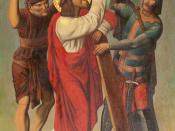Today in class, I realized that I had for years taken the Crucifixion more or less for granted. That I had grown indifferent or perhaps that I never really thought of it as a very gruesome way to die. Today was the first time that the actual medical presentation of how Christ died on the cross and all the pain and punishment that he endured hit me somewhere deep in my heart. What a terrible and inhumane ordeal Jesus was willing to go thru, to save us sinners.
Today as I watched this documentary on the final hours of Jesus life it finally occurred to me that, of all my years going to church and hearing about God's crucifixion and resurrection I didn't even know the actual immediate cause of death of our savior.
Crucifixion Background.
Apparently, the first known practice of crucifixion was by the Persians. Alexander and his generals brought it back to the Mediterranean world -- to Egypt and to Carthage.
The Romans apparently learned the practice from the Carthaginians and (as with almost everything the Romans did) rapidly developed a very high degree of efficiency and skill at it. A number of Roman authors (Livy, Cicer, Tacitus) comment on crucifixion, and several innovations, modifications, and variations are described in the ancient literature.
For instance, the upright portion of the cross (or stipes) could have the cross-arm (or patibulum) attached two or three feet below its top in what we commonly think of as the Latin cross. The most common form used in our Lord's day, however, was the Tau cross, shaped like our T. In this cross the patibulum was placed in a notch at the top of the stipes. There is archeological evidence that it was on this type of cross that Jesus was crucified...


